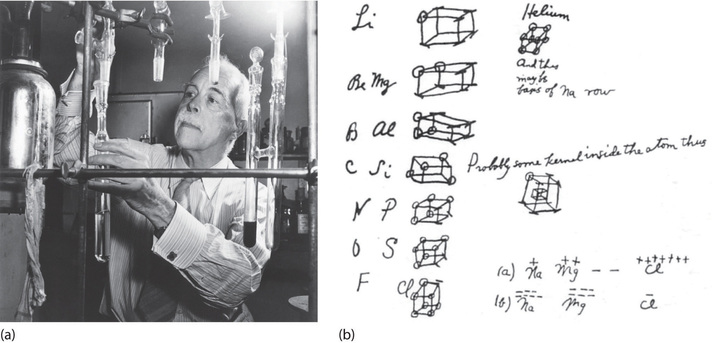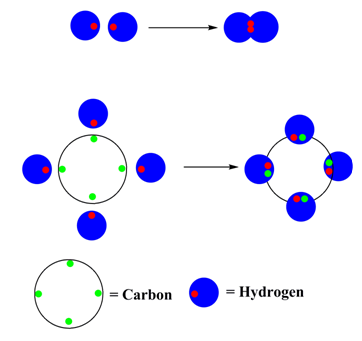Lewis Dot Structure Periodic Table
8.one: Lewis Dot Symbols and the Octet Rule
- Page ID
- 81342
Skills to Develop
- To use Lewis electron dot symbols to predict the number of bonds an chemical element will course.
Why are some substances chemically bonded molecules and others are an association of ions? The answer to this question depends upon the electronic structures of the atoms and nature of the chemical forces within the compounds. Although there are no sharply defined boundaries, chemical bonds are typically classified into three main types: ionic bonds, covalent bonds, and metallic bonds. In this chapter, each type of bail volition exist discussed and the full general backdrop found in typical substances in which the bond type occurs
- Ionic bonds results from electrostatic forces that exist between ions of opposite charge . These bonds typically involves a metallic with a nonmetal
- Covalent bonds upshot from the sharing of electrons betwixt 2 atoms . The bonds typically involves one nonmetallic chemical element with another
- Metallic bonds These bonds are found in solid metals (copper, iron, aluminum) with each metallic bonded to several neighboring groups and bonding electrons gratis to move throughout the 3-dimensional structure.
Each bail classification is discussed in detail in subsequent sections of the chapter. Permit'south look at the preferred arrangements of electrons in atoms when they form chemic compounds.

Figure \(\PageIndex{1}\) : G. Northward. Lewis and the Octet Rule. (a) Lewis is working in the laboratory. (b) In Lewis'southward original sketch for the octet dominion, he initially placed the electrons at the corners of a cube rather than placing them as we do now.
Lewis Symbols
At the beginning of the 20th century, the American chemist Grand. Due north. Lewis (1875–1946) devised a system of symbols—now chosen Lewis electron dot symbols (oftentimes shortened to Lewis dot symbols) that can be used for predicting the number of bonds formed by most elements in their compounds. Each Lewis dot symbol consists of the chemical symbol for an element surrounded past dots that represent its valence electrons.
Lewis Dot symbols
- convenient representation of valence electrons
- allows you to keep track of valence electrons during bail formation
- consists of the chemical symbol for the element plus a dot for each valence electron
To write an element'due south Lewis dot symbol, we place dots representing its valence electrons, 1 at a time, around the element'southward chemical symbol. Upwardly to four dots are placed to a higher place, below, to the left, and to the right of the symbol (in whatsoever order, equally long as elements with four or fewer valence electrons have no more 1 dot in each position). The next dots, for elements with more than 4 valence electrons, are again distributed i at a time, each paired with 1 of the starting time iv. For example, the electron configuration for atomic sulfur is [Ne]3stwo3p4, thus in that location are six valence electrons. Its Lewis symbol would therefore be:
Fluorine, for case, with the electron configuration [He]2due south 22p v, has 7 valence electrons, so its Lewis dot symbol is constructed as follows:

The number of dots in the Lewis dot symbol is the same as the number of valence electrons, which is the same every bit the last digit of the element's grouping number in the periodic table. Lewis dot symbols for the elements in period 2 are given in Figure \(\PageIndex{ii}\).
Lewis used the unpaired dots to predict the number of bonds that an element will course in a compound. Consider the symbol for nitrogen in Figure \(\PageIndex{ii}\). The Lewis dot symbol explains why nitrogen, with three unpaired valence electrons, tends to form compounds in which it shares the unpaired electrons to form three bonds. Boron, which as well has three unpaired valence electrons in its Lewis dot symbol, likewise tends to form compounds with three bonds, whereas carbon, with four unpaired valence electrons in its Lewis dot symbol, tends to share all of its unpaired valence electrons by forming compounds in which information technology has iv bonds.
Figure \(\PageIndex{two}\): Lewis Dot Symbols for the Elements in Period 2
The Octet Dominion
In 1904, Richard Abegg formulated what is at present known as Abegg'south rule, which states that the difference between the maximum positive and negative valences of an chemical element is often viii. This dominion was used afterwards in 1916 when Gilbert N. Lewis formulated the "octet rule" in his cubical atom theory.
The octet rule refers to the tendency of atoms to prefer to have viii electrons in the valence shell. When atoms accept fewer than eight electrons, they tend to react and course more stable compounds. Atoms will react to go far the most stable state possible. A complete octet is very stable considering all orbitals will be full. Atoms with greater stability have less energy, so a reaction that increases the stability of the atoms volition release energy in the form of rut or low-cal ;reactions that subtract stability must absorb energy, getting colder.
When discussing the octet dominion, nosotros do not consider d or f electrons. But the due south and p electrons are involved in the octet rule, making it a useful dominion for the chief group elements (elements not in the transition metal or inner-transition element blocks); an octet in these atoms corresponds to an electron configurations catastrophe with southwardtwop6.
Octet Dominion
A stable arrangement is attended when the cantlet is surrounded by viii electrons. This octet can be made up by ain electrons and some electrons which are shared. Thus, an atom continues to form bonds until an octet of electrons is made. This is known as octet rule past Lewis.
- Normally ii electrons pairs up and forms a bail, eastward.g., \(H_2\)
- For most atoms there will be a maximum of eight electrons in the valence vanquish (octet structure), e.g., \(CH_4\)

Figure \(\PageIndex{3}\): Bonding in \(H_2\) and methane (\(CH_4\))
The other tendency of atoms is to maintain a neutral charge. Only the noble gases (the elements on the right-most column of the periodic table) have nothing charge with filled valence octets. All of the other elements have a charge when they have 8 electrons all to themselves. The consequence of these two guiding principles is the explanation for much of the reactivity and bonding that is observed within atoms: atoms seek to share electrons in a way that minimizes charge while fulfilling an octet in the valence crush.
The noble gases rarely course compounds. They have the nearly stable configuration (full octet, no charge), then they have no reason to react and change their configuration. All other elements attempt to proceeds, lose, or share electrons to reach a element of group 0 configuration.
Instance \(\PageIndex{1}\): Salt
The formula for table common salt is NaCl. It is the result of Na+ ions and Cl- ions bonding together. If sodium metal and chlorine gas mix under the right weather, they will form table salt. The sodium loses an electron, and the chlorine gains that electron. In the process, a great amount of light and heat is released. The resulting table salt is mostly unreactive — it is stable. It volition non undergo any explosive reactions, unlike the sodium and chlorine that it is made of. Why?
SOLUTION
Referring to the octet dominion, atoms attempt to get a noble gas electron configuration, which is eight valence electrons. Sodium has one valence electron, and then giving information technology upward would result in the same electron configuration as neon. Chlorine has seven valence electrons, then if it takes one it will have viii (an octet). Chlorine has the electron configuration of argon when it gains an electron.
The octet rule could have been satisfied if chlorine gave up all seven of its valence electrons and sodium took them. In that case, both would have the electron configurations of noble gasses, with a total valence beat. Nonetheless, their charges would be much higher. It would exist \(\ce{Na^{vii-}}\) and \(\ce{Cl^{7+}}\), which is much less stable than \(\ce{Na^{+}}\) and \(\ce{Cl^{-}}\). Atoms are more stable when they accept no charge, or a small charge.
Lewis dot symbols can also be used to represent the ions in ionic compounds. The reaction of cesium with fluorine, for example, to produce the ionic compound CsF can exist written as follows:

No dots are shown on \(\ce{Cs^{+}}\) in the product because cesium has lost its single valence electron to fluorine. The transfer of this electron produces the \(\ce{Cs^{+}}\) ion, which has the valence electron configuration of \(\ce{Xe}\), and the \(\ce{F^{−}}\) ion, which has a total of 8 valence electrons (an octet) and the Ne electron configuration. This clarification is consistent with the statement that amidst the principal grouping elements, ions in elementary binary ionic compounds generally accept the electron configurations of the nearest noble gas. The charge of each ion is written in the product, and the anion and its electrons are enclosed in brackets. This annotation emphasizes that the ions are associated electrostatically; no electrons are shared between the two elements.
Atoms often proceeds, lose, or share electrons to attain the aforementioned number of electrons as the element of group 0 closest to them in the periodic table.
Equally y'all might expect for such a qualitative approach to bonding, there are exceptions to the octet rule, which nosotros describe elsewhere. These include molecules in which one or more than atoms incorporate fewer or more than eight electrons.
Summary
- Lewis dot symbols can be used to predict the number of bonds formed past most elements in their compounds.
Ane convenient way to predict the number and bones arrangement of bonds in compounds is by using Lewis electron dot symbols, which consist of the chemical symbol for an element surrounded by dots that represent its valence electrons, grouped into pairs oftentimes placed to a higher place, below, and to the left and right of the symbol. The structures reverberate the fact that the elements in period ii and across tend to gain, lose, or share electrons to reach a full of eight valence electrons in their compounds, the and then-chosen octet rule. Hydrogen, with only ii valence electrons, does not obey the octet rule.
Lewis Dot Structure Periodic Table,
Source: https://chem.libretexts.org/Courses/Valley_City_State_University/Chem_121/Chapter_8%3A_Chemical_Bonding_and_Molecular_Structures/8.1%3A_Lewis_Dot_Symbols_and_the_Octet_Rule
Posted by: bowennack1994.blogspot.com


0 Response to "Lewis Dot Structure Periodic Table"
Post a Comment